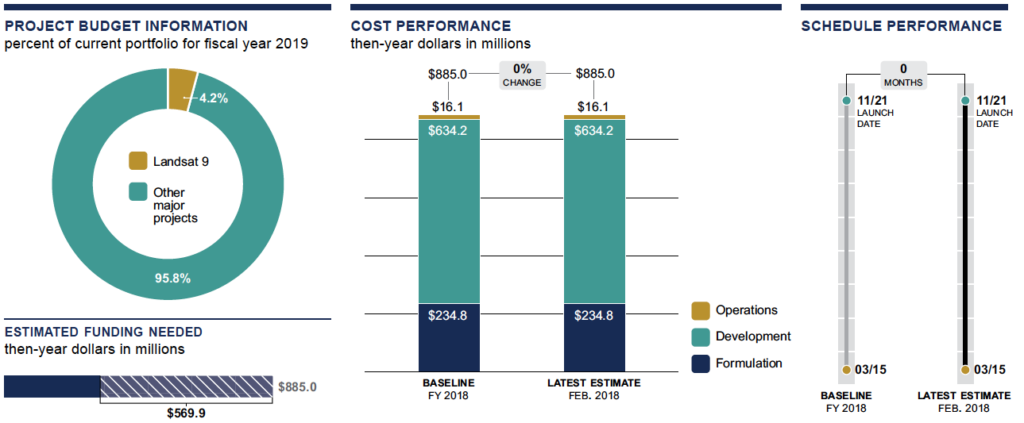===

Landsat 9 Cost and Schedule Status
The Landsat 9 project entered the implementation phase in December 2017 and formally established its cost and schedule baselines. The project set a baseline life-cycle cost of $885 million and a launch date of November 2021. However, the project is working toward a launch readiness date of December 2020* due to direction in the Explanatory Statement accompanying the Consolidated Appropriations Act, 2016. According to officials, this earlier launch date will help ensure that the Landsat program is able to maintain two Landsat satellites on-orbit simultaneously, which is a goal of the scientific community, but not a requirement for the program. NASA calculated the project’s joint cost and schedule confidence level, the likelihood a project will meet its cost and schedule estimate, at 47 percent for the earlier December 2020 launch date. This is slightly lower than the 50 percent required by NASA policy. However, for the baselined launch date of November 2021, the joint cost and schedule confidence level is greater than 70 percent, which meets the requirement in NASA policy.
As a result of working to this earlier launch date, the project is holding schedule reserves below the level required by NASA center policy. This means the project would have less time to address known and unknown risks without affecting its December 2020 launch date. The project considers this schedule challenging, but achievable because of the high use of heritage technologies, mature instrument designs, and extensive use of hardware from the prior Landsat mission, Landsat 8. In addition, project officials said they have confidence that the project can meet this date because they have been executing to this aggressive schedule without needing any schedule reserves. The project is holding cost reserves at the level required by NASA center policy.
*In commenting on a draft of this assessment, Landsat 9 project officials stated that all project elements are successfully making progress and on track to support a December 2020 launch readiness date.
Landsat 9 Technology and Design
The Landsat 9 project proceeded into implementation with mature technologies. The project held its preliminary design review in September 2017 with mature technologies and stable instrument designs due to high use of heritage technologies and designs from Landsat 8. Utilizing heritage technologies and designs on projects can help to reduce risk and control costs when they are used for similar purposes in similar environments. Specifically, Landsat 9’s instruments—Thermal Infrared Sensor-2 and Operational Land Imager-2—are at a technology readiness level 9 and all components in the flight segments are above a technology readiness level 6. Maturing technologies to a technology readiness level 6 by preliminary design review is a best practice and helps minimize risks for space systems entering product development.
The project also proceeded into implementation with the designs of its two instruments stable. The project plan to hold its critical design review in April 2018. Our work on product development best practices shows that at least 90 percent of design drawings should be released by critical design review to lower the risk of subsequent cost and schedule growth. As of January 2018, the project had released about 64 percent of its design drawings. The project completed critical design reviews for its two instruments prior to mission preliminary design review due to the high level of heritage designs from Landsat 8, and has released over 90 percent of drawings for both. Most of the drawings that have not been released are for the spacecraft. The project’s spacecraft also has a design similar to that of Landsat 8 and uses heritage components from other Earth-orbiting satellites. The project plans to hold its spacecraft critical design review in February 2018.
===
+ GAO Landsat 9 report pages [PDF]






